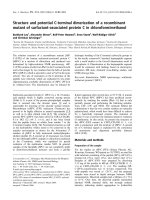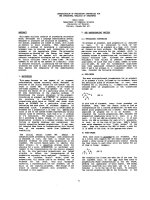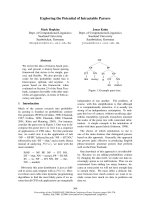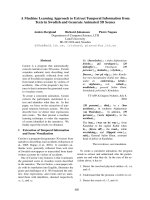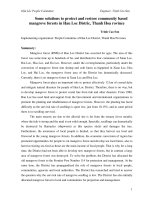Báo cáo khoa học: "Bench-to-bedside review: Potential strategies to protect or reverse mitochondrial dysfunction in sepsis-induced organ failure" pps
Bạn đang xem bản rút gọn của tài liệu. Xem và tải ngay bản đầy đủ của tài liệu tại đây (351.71 KB, 7 trang )
Page 1 of 7
(page number not for citation purposes)
Available online />Abstract
The pathogenesis of sepsis-induced multiple organ failure may
crucially depend on the development of mitochondrial dysfunction
and consequent cellular energetic failure. According to this hypo-
thesis, interventions aimed at preventing or reversing mitochondrial
damage may have major clinical relevance, although the timing of
such interventions will be critical to both ensuring benefit and
avoiding harm. Early correction of tissue hypoxia, strict control of
glycaemia, and modulation of oxidative and nitrosative stress may
afford protection during the initial, acute systemic inflammatory
response. The regulated induction of a hypometabolic state
resembling hibernation may protect the cells from dying once
energy failure has developed, allowing the possibility of functional
recovery. Repair of damaged organelles through stimulation of
mitochondrial biogenesis and reactivation of cellular metabolism
may accelerate resolution of the multiple organ failure syndrome.
Introduction
Sepsis is the systemic inflammatory response to infection and
represents a major cause of morbidity and mortality in patients
admitted to intensive care units (ICUs) [1]. However, despite
decades of research, the pathophysiology of sepsis remains
incompletely understood. A critical limitation of tissue oxygen
delivery due to macrocirculatory or microcirculatory failure may
play a role, especially in the early phase of the disease
process before resuscitation has been initiated. Nonetheless,
a growing body of evidence suggests that multiple organ
failure (MOF) may develop during sepsis mainly as a
consequence of impaired cellular oxygen utilization.
Supportive data in patients include the following findings: total
body oxygen consumption falls progressively with increasing
severity of sepsis [2]; skeletal muscle tissue oxygen tension is
abnormally high but normalizes during the recovery phase [3];
necrotic and apoptotic cell death is minimal, if it occurs at all,
in most dysfunctioning organs [4]; and organs with limited
regenerative capabilities, such as kidney, are usually able to
recover to such an extent that long-term support is usually not
needed [5]. Sepsis-induced MOF may thus be related to a
potentially reversible impairment in cellular function rather than
any permanent structural damage.
The mitochondrion is the powerhouse of the cell [6]. Cellular
energy production depends on three interconnected
pathways: glycolysis within the cytoplasm, the Krebs cycle
and the electron transport chain within the mitochondria
(Figure 1). Glycolysis is a sequence of reactions that degrade
glucose to pyruvate. In the presence of oxygen, pyruvate and
other fuel molecules such as fatty acids and amino acids
enter the mitochondria, where they are completely oxidized
within the Krebs cycle. The reduced nicotinamide (NADH)
and flavin (FADH
2
) adenine dinucleotides transfer electrons
to the respiratory enzyme complexes located in the inner
mitochondrial membrane (electron transport chain) for the
process of ATP generation by oxidative phosphorylation.
NADH donates electrons specifically to complex I whereas
FADH
2
reduces complex II. The electrons then flow via
coenzyme Q (ubiquinone) to complex III, and are then
transported via cytochrome C to reach complex IV
(cytochrome oxidase). At this final stage, oxygen is reduced
to water. Electron transfer through complexes I, III and IV
generates a proton gradient across the inner mitochondrial
membrane that is used by ATP synthase (complex V) to
generate energy by phosphorylating ADP. The complete
oxidation of one molecule of glucose yields 30-36 molecules
of ATP, two of which come from glycolysis and two from the
Krebs cycle. Glycolysis can also occur in the absence of
oxygen. However, when oxygen is lacking, pyruvate can no
longer be further oxidized within the mitochondria and is thus
metabolized to lactate within the cytoplasm. Glycolysis
represents a much less efficient metabolic pathway compared
with the Krebs cycle and oxidative phosphorylation, because
Review
Bench-to-bedside review: Potential strategies to protect or
reverse mitochondrial dysfunction in sepsis-induced organ failure
Alessandro Protti
1,2
and Mervyn Singer
1
1
Bloomsbury Institute of Intensive Care Medicine, Wolfson Institute for Biomedical Research and Department of Medicine, University College London,
London, UK
2
Istituto di Anestesia e Rianimazione, Ospedale Maggiore Policlinico, Mangiagalli e Regina Elena – IRCCS, Milan, Italy
Corresponding author: Mervyn Singer,
Published: 1 September 2006 Critical Care 2006, 10:228 (doi:10.1186/cc5014)
This article is online at />© 2006 BioMed Central Ltd
FADH
2
= flavin adenine dinucleotide, reduced; ICU = intensive care unit; MOF = multiple organ failure; NADH = nicotinamide adenine dinucleotide,
reduced; NO = nitric oxide; NOS = nitric oxide synthase; T
3
= tri-iodothyronine.
Page 2 of 7
(page number not for citation purposes)
Critical Care Vol 10 No 5 Protti and Singer
there is net synthesis of only two molecules of ATP per
molecule of glucose [7].
Because mitochondria utilize more than 90% of total body
oxygen consumption to produce ATP, the abnormalities in
oxygen consumption described during sepsis are likely to be
associated with evidence of mitochondrial dysfunction.
Studies conducted during the early phase of sepsis (within
the first few hours) have produced conflicting results.
Nonetheless, mitochondrial structure and function were
consistently shown to be impaired in a severity-dependent
manner in animal models lasting at least 12-16 hours [8]. Of
note, ATP levels were variably affected, depending on the
balance between energy production and consumption, the
model and possibly the tissue under investigation. In septic
shock patients studied within 24 hours of ICU admission, the
degree of skeletal muscle mitochondrial dysfunction was
associated with the severity of the disease [9]. In this work,
tissue ATP levels were significantly lower in nonsurvivors than
in an orthopaedic surgical control population, but they were
maintained in those who survived sepsis.
A reduction in energy consumption implies a reduction in
cellular metabolism, which manifests clinically as organ
dysfunction. Rather than being viewed negatively as ‘failure’,
an alternative paradigm may be advanced whereby this
metabolic shutdown represents an adaptive cellular strategy
[10]. In the face of persisting mitochondrial dysfunction and
reduced ATP production, the cell may shift its focus to
survival rather than aiming to continue normal functioning.
The pathogenesis of mitochondrial dysfunction during sepsis
is likely to be highly complex. Nitric oxide (NO), reactive
oxygen species and other inflammatory mediators are produced
in excess and can directly inhibit mitochondrial respiration.
NO competes with oxygen in binding to cytochrome oxidase
(complex IV), thereby decreasing the activity of the enzyme.
This will block the electron transport chain and lead to over-
production of superoxide. Superoxide will react with NO to
generate peroxynitrite and other nitrogen species that are
able to alter the structure and function of several other
mitochondrial proteins, notably complex I [11]. Early cellular
hypoxia may favour the competitive NO-mediated inhibition of
cytochrome oxidase, contributing to the earlier, if not greater,
development of mitochondrial dysfunction [12].
Endocrine changes that occur during sepsis are also likely to
play a role. Among others, thyroid and sex hormones, insulin,
glucocorticoids and leptin positively modulate mitochondrial
energy production, protein synthesis and biogenesis [13-17].
Increased incidences of the low tri-iodothyronine (T
3
)
syndrome, hypogonadism, insulin resistance, adrenal
insufficiency and decreased circulating leptin levels in
nonsurvivors compared with survivors have been reported
Figure 1
Schematic representation of oxidative phosphorylation within the mitochondria. Electrons donated from NADH and FADH
2
pass down the electron
transport chain with oxygen being the terminal acceptor at complex IV. This movement of electrons results in a shift of protons across the inner
mitochondrial membrane, generating the energy necessary for ATP synthase to produce ATP from ADP. FADH
2
, flavin adenine dinucleotide,
reduced; NADH, nicotinamide adenine dinucleotide, reduced.
Page 3 of 7
(page number not for citation purposes)
during prolonged sepsis and critical illness [18,19].
Accordingly, depletion of respiratory complex proteins has
been described in the diaphragm in a rat model of sepsis [20].
A further mechanism could be represented by the down-
regulated synthesis of new mitochondrial protein. In human
volunteers, administration of bacterial endotoxin decreased
blood leucocyte expression of mitochondrial respiratory chain
complexes and ATP synthase genes [21].
Assuming that the pathogenesis of MOF during sepsis is
contingent on development of mitochondrial dysfunction and
cellular energetic failure, recovery is likely to occur when
damaged organelles are repaired or replaced. Preliminary
results have shown an association between progressive
improvement in mitochondrial respiration and organ function
in patients who survive their episode of septic shock [22].
Strategies aimed at preventing or reversing mitochondrial
dysfunction and cellular energetic failure may thus represent
a new therapeutic option in the treatment of sepsis (Figure 2).
Prevention and early reversal of
mitochondrial dysfunction
Mitochondrial dysfunction in sepsis can occur even with
aggressive fluid resuscitation [23] and adequate tissue
oxygenation [24,25]. Derangement in liver metabolism possibly
due to mitochondrial damage was recently reported in a
hyperdynamic, normotensive, mechanically ventilated, anti-
biotic-treated septic animal model, despite preserved
microvascular perfusion [26]. Nonetheless, early cellular
hypoxia can further limit aerobic production of ATP and
contribute to the development of energy failure.
Optimization of oxygen delivery can ameliorate cellular
energetic failure provided that mitochondria retain their ability
to produce energy. Patients with severe sepsis or septic
shock whose global oxygen delivery was optimized early after
admission to an emergency room experienced better
outcomes than did conventionally managed patients [27].
Conversely, no benefit [28] or even harm [29] was reported
when a similar approach was adopted after admission to ICU,
when organ failure had already become established. The
same intervention, performed at different time points, had very
different clinical impacts. In the early phase, when the cellular
energetic machinery is still likely to be functional and oxygen
supply may represent a limiting factor, reversal of tissue
hypoxia may ameliorate the impending cellular energetic
failure and reduce the incidence/severity of organ dys-
function. In a later phase, when mitochondrial damage has
occurred and the cell has become intrinsically unable to
utilize oxygen to produce ATP, a similar strategy may not
provide any benefit. Lack of improvement in oxygen
consumption despite a re-established oxygen supply has
Available online />Figure 2
Hypothesized role of mitochondria in the development of MOF and subsequent recovery. Potential therapeutic interventions are illustrated at the
appropriate steps. MOF, multiple organ failure.
been associated with unfavourable outcomes in patients with
sepsis syndrome or septic shock [30].
Hyperglycaemia and insulin resistance are common among
critically ill patients and represent an additional potential
threat to mitochondrial integrity. Acute hyperglycaemia can
dramatically increase the production of reactive oxygen
species in normal bovine aortic endothelial cells [31].
Moreover, insulin stimulates mitochondrial protein synthesis
and oxidative phosphorylation [15]. Maintenance of normo-
glycaemia with intensive insulin therapy during critical illness
has been demonstrated to preserve hepatocyte mitochondrial
ultrastructure and function [32] and improve outcome in both
medical and surgical intensive care patients [33,34].
Reactive oxygen and nitrogen species are over-produced
during sepsis, whereas mitochondrial antioxidants (reduced
glutathione and manganese superoxide) are depleted. The
membrane permeable glutathione ethyl ester can protect
complex I from oxidative and nitrosative damage in an early
phase [35]. Manganese-based superoxide dismutase mimetics
may exert a similar protective effect, scavenging superoxide
anions and preventing them from further reacting with NO to
generate peroxynitrite within the mitochondria [36].
Prevention of cellular energetic failure in the
presence of mitochondrial dysfunction
Once permanent mitochondrial dysfunction has developed,
cellular optimization of any residual ability to produce energy
and/or reduce metabolic requirements may prevent the ATP
level from dropping below the threshold that stimulates
initiation of cell death pathways.
Electron donors that are able to ‘bypass’ defective
components of the respiratory chain may help in attaining the
former objective. Within the inner mitochondrial membrane,
complex II works in parallel with complex I, albeit to a lesser
extent, transferring electrons from FADH
2
produced during the
oxidation of succinate to coenzyme Q. Unlike complex I, the
activity of complex II is relatively preserved during sepsis
[9,23,37]. When complex I is inhibited, the administration of
succinate may increase electron flow through the respiratory
chain and thus increase generation of ATP, provided that any
inhibition of the electron transport chain distal to complex II
has not become rate-limiting. Preliminary data from our
laboratory confirm this action. In two different animal models of
sepsis, the infusion of succinate dimethyl ester prevented the
fall in liver ATP content [38] and prolonged survival time [39].
Another possible strategy that could be pursued in the face
of a severe and extended impairment in mitochondrial energy
production is to reduce cellular energetic expenditure.
Hibernating and aestivating animals reduce their metabolic
rate in the face of climate change or drought. Similarly,
oxygen-conforming organisms such as turtles and frogs can
tolerate prolonged periods of hypoxia by suppressing ATP
turnover [40]. Humans do not hibernate or aestivate and have
only a limited tolerance to inadequate oxygenation. Nonethe-
less, patients with chronic coronary artery disease frequently
develop a myocardial contractile dysfunction – termed
myocardial hibernation – that may represent an adaptive
response to ischaemia, rather than depend on an ongoing
energetic deficit, which will recover on restoration of
adequate perfusion [41].
Mechanism(s) governing hibernation remain to be clarified.
Carbon monoxide and NO may mediate the active decrease
in energy demand that occurs in cells that lack oxygen
[42,43]. The natural peptide ‘hibernation induction trigger‘, its
synthetic analogue [D-Ala
2
, D-Leu
5
] enkephalin (DADLE) and
other δ-opioids can also reduce cellular metabolism and
protect organs against ischaemia [44]. Rapid induction of
profound cerebral hypothermia in animals that do not normally
hibernate may guarantee protection during prolonged cardio-
circulatory arrest [45]. Mice exposed to hydrogen sulphide
experience a dramatic decrease in their metabolic rate: within
6 hours, oxygen consumption and carbon dioxide production
drop by around 90%, and body core temperature approaches
that of the environment [46]. Such a suspended animation-
like state fully reverses when the hydrogen sulphide is
discontinued, without any permanent behavioural or
functional damage. It is conceivable that, even during sepsis,
induced hibernation may protect the organism from
prolonged energetic failure and enable faster recovery on
resolution of the inflammatory insult. Some caveats do need to
be applied. For example, the hyperthermic response to infec-
tion activates the expression of cytoprotective heat shock
proteins and may therefore be considered beneficial [47].
Therapeutic induction of hibernation may remove this intrinsic
protective mechanism with potentially deleterious results.
The converse may also hold true. Premature stimulation of
cellular metabolism before mitochondria have regained their
ability to respond adequately in terms of energy production may
lead to cellular compromise. Examples of harmful therapeutic
approaches that may be invoked are the use of high-dose
dobutamine [29], thyroxine [48] and growth hormone [49].
Resolution of mitochondrial dysfunction:
arousal from ‘hibernation’
Repair and replacement of damaged mitochondria are
probably controlled at a transcriptional level, but proximal
steps in the signalling pathway still need to be elucidated.
NO was recently suggested to play a major role. Long-term
exposure to a low concentration of the gas triggered
expression of transcriptional factors that regulate mito-
chondrial proliferation and significantly increased mito-
chondrial mass in different cells in culture [50]. NO exerts
different actions depending on the rate, amount and site of
production. The large quantity synthesized by the inducible
isoform of nitric oxide synthase (NOS) during the acute
inflammatory response to sepsis blocks mitochondrial
Critical Care Vol 10 No 5 Protti and Singer
Page 4 of 7
(page number not for citation purposes)
respiration and can be cytotoxic. On the other hand, the
smaller amounts of NO produced by the specific constitutive
endothelial NOS may trigger mitochondrial biogenesis in a
later phase. Nitration also dramatically accelerates mito-
chondrial protein turnover, from days to hours [51]. Taken
together, these results suggest that recovery from mito-
chondrial dysfunction may depend on a NO-dependent
signalling pathway. Specific inhibition of inducible NOS
during sepsis may represent a potential therapeutic strategy
[52-55], although dose selection will be critical. This is
pertinent to the dose-related increase in mortality reported in
a phase III trial of a nonspecific NOS inhibitor in septic shock
patients [56]. Indeed, the overall negative outcome of this
study camouflages the survival benefit seen with low doses.
Hormones may play an equally important role. Thyroid
hormones stimulate mitochondrial activity. Injection of T
3
in
hypothyroid rats upregulated mitochondrial biogenesis-related
transcription factors [57]. In contrast to the acute response,
persistently low circulating levels of T
3
during the prolonged
phase of critical illness may be due to neuroendocrine
dysfunction [18]. Replacement hormonal therapy given at the
right time, when cells have regained the ability to both restore
mitochondrial activity and increase metabolic rate, may
beneficially arouse the cell and promote earlier organ
recovery. However, as described above, thyroxine supple-
mentation may prove dangerous [48], and so the right
conditions must be in place.
Other hormones that could be considered in the treatment of
sepsis are leptin and oestrogen. Leptin is a hormone secreted
by adipose tissue. It regulates food intake and energy balance
to maintain constancy of total body fat mass. In diabetic fatty
rats, ectopic hyperleptinaemia triggered mitochondrial
proliferation, transforming white adipocytes into mitochondria-
rich, fat-oxidizing cells [17]. Administration of oestrogen or
antiandrogen agents after trauma/haemorrhage also increased
mitochondrial enzyme activities, protein synthesis and ATP
levels relative to those in sham-operated controls [58].
A further biological equivalent to sepsis-induced hibernation
is bacterial dormancy. This is a reversible, low-growth state
well recognized in mycobacteria such as Mycobacterium
tuberculosis. Micrococcus luteus can be aroused from its
quiescent phase by an endogenous protein named
‘resuscitation promoting factor’ [59]. As mitochondria
descend from a bacterial endosymbiont, the identification and
application of a similar protein that can specifically stimulate
mitochondrial activity may well yield beneficial results.
Conclusion
Mitochondrial dysfunction occurs during sepsis and may play
a major role in the development of MOF.
Prevention and correction of mitochondrial dysfunction and
cellular energetic failure represent novel strategies that may
improve clinical outcomes of septic patients. Timing of any
intervention appears to be critical and the possibly adaptive
role of some changes currently viewed as pathological must
be considered. The regulated induction of a hypometabolic
state resembling hibernation may help the cell in facing a
reduced capacity to generate energy. The stimulation of
mitochondrial activity and biogenesis during the late phase of
sepsis may accelerate the recovery process. This increasing
insight into underlying mechanisms promises to be an
exciting era of novel therapeutic developments.
Competing interests
MS receives research funding from the Medical Research
Council and Wellcome Trust to undertake basic science
research on mitochondria.
References
1. Padkin A, Goldfrad C, Brady AR, Young D, Black N, Rowan K:
Epidemiology of severe sepsis occurring in the first 24 hrs in
intensive care units in England, Wales, and Northern Ireland.
Crit Care Med 2003, 31:2332-2338.
2. Kreymann G, Grosser S, Buggisch P, Gottschall C, Matthaei S,
Greten H: Oxygen consumption and resting metabolic rate in
sepsis, sepsis syndrome, and septic shock. Crit Care Med
1993, 21:1012-1019.
3. Boekstegers P, Weidenhofer S, Kapsner T, Werdan K: Skeletal
muscle partial pressure of oxygen in patients with sepsis. Crit
Care Med 1994, 22:640-650.
4. Hotchkiss RS, Swanson PE, Freeman BD, Tinsley KW, Cobb JP,
Matuschak GM, Buchman TG, Karl IE: Apoptotic cell death in
patients with sepsis, shock, and multiple organ dysfunction.
Crit Care Med 1999, 27:1230-1251.
5. Noble JS, MacKirdy FN, Donaldson SI, Howie JC: Renal and res-
piratory failure in Scottish ICUs. Anaesthesia 2001, 56:124-
129.
6. Rich P: Chemiosmotic coupling: the cost of living. Nature
2003, 421:583.
7. Alberts B, Johnson A, Lewis J, Raff M, Roberts K, Walter P: Mole-
cular Biology of the Cell. New York: Garland Publishing; 2002.
8. Singer M, Brealey D: Mitochondrial dysfunction in sepsis.
Biochem Soc Symp 1999, 66:149-166.
9. Brealey D, Brand M, Hargreaves I, Heales S, Land J, Smolenski R,
Davies NA, Cooper CE, Singer M: Association between mito-
chondrial dysfunction and severity and outcome of septic
shock. Lancet 2002, 360:219-223.
10. Singer M, De Santis V, Vitale D, Jeffcoate W: Multiorgan failure
is an adaptive, endocrine-mediated, metabolic response to
overwhelming systemic inflammation. Lancet 2004, 364:545-
548.
11. Liaudet L, Soriano FG, Szabo C: Biology of nitric oxide signal-
ing. Crit Care Med 2000, 28:N37-N52.
12. Frost MT, Wang Q, Moncada S, Singer M: Hypoxia accelerates
nitric oxide-dependent inhibition of mitochondrial complex I
in activated macrophages. Am J Physiol Regul Integr Comp
Physiol 2005, 288:R394-R400.
13. Weitzel JM, Iwen KA, Seitz HJ: Regulation of mitochondrial bio-
genesis by thyroid hormone. Exp Physiol 2003, 88:121-128.
14. Stirone C, Duckles SP, Krause DN, Procaccio V: Estrogen
increases mitochondrial efficiency and reduces oxidative
stress in cerebral blood vessels. Mol Pharmacol 2005, 68:959-
965.
15. Stump CS, Short KR, Bigelow ML, Schimke JM, Nair KS: Effect
of insulin on human skeletal muscle mitochondrial ATP pro-
duction, protein synthesis, and mRNA transcripts. Proc Natl
Acad Sci USA 2003, 100:7996-8001.
16. Scheller K, Sekeris CE: The effects of steroid hormones on the
transcription of genes encoding enzymes of oxidative phos-
phorylation. Exp Physiol 2003, 88:129-140.
17. Orci L, Cook WS, Ravazzola M, Wang MY, Park BH, Montesano R,
Unger RH: Rapid transformation of white adipocytes into fat-oxi-
dizing machines. Proc Natl Acad Sci USA 2004, 101:2058-2063.
Available online />Page 5 of 7
(page number not for citation purposes)
18. Van den Berghe G, de Zegher F, Bouillon R: Clinical review 95:
acute and prolonged critical illness as different neuroendocrine
paradigms. J Clin Endocrinol Metab 1998, 83:1827-1834.
19. Bornstein SR, Licinio J, Tauchnitz R, Engelmann L, Negrao AB,
Gold P, Chrousos GP: Plasma leptin levels are increased in
survivors of acute sepsis: associated loss of diurnal rhythm,
in cortisol and leptin secretion. J Clin Endocrinol Metab 1998,
83:280-283.
20. Callahan LA, Supinski GS: Sepsis induces diaphragm electron
transport chain dysfunction and protein depletion. Am J Respir
Crit Care Med 2005, 172:861-868.
21. Calvano SE, Xiao W, Richards DR, Felciano RM, Baker HV, Cho
RJ, Chen RO, Brownstein BH, Cobb JP, Tschoeke SK, et al.: A
network-based analysis of systemic inflammation in humans.
Nature 2005, 437:1032-1037.
22. Brealey DA, Hargreaves I, Heales S, Land J, Smolenski R, Singer
M: Recovery from organ failure is associated with improved
mitochondrial function in septic patients [abstract]. Intensive
Care Med 2003, 29:S134.
23. Brealey D, Karyampudi S, Jacques TS, Novelli M, Stidwill R, Taylor
V, Smolenski RT, Singer M: Mitochondrial dysfunction in a long-
term rodent model of sepsis and organ failure. Am J Physiol
Regul Integr Comp Physiol 2004, 286:R491-R497.
24. VanderMeer TJ, Wang H, Fink MP: Endotoxemia causes ileal
mucosal acidosis in the absence of mucosal hypoxia in a nor-
modynamic porcine model of septic shock. Crit Care Med
1995, 23:1217-1226.
25. Rosser DM, Stidwill RP, Jacobson D, Singer M: Oxygen tension
in the bladder epithelium rises in both high and low cardiac
output endotoxemic sepsis. J Appl Physiol 1995, 79:1878-
1882.
26. Albuszies G, Radermacher P, Vogt J, Wachter U, Weber S,
Schoaff M, Georgieff M, Barth E: Effect of increased cardiac
output on hepatic and intestinal microcirculatory blood flow,
oxygenation, and metabolism in hyperdynamic murine septic
shock. Crit Care Med 2005, 33:2332-2338.
27. Rivers E, Nguyen B, Havstad S, Ressler J, Muzzin A, Knoblich B,
Peterson E, Tomlanovich M: Early goal-directed therapy in the
treatment of severe sepsis and septic shock. N Engl J Med
2001, 345:1368-1377.
28. Gattinoni L, Brazzi L, Pelosi P, Latini R, Tognoni G, Pesenti A,
Fumagalli R: A trial of goal-oriented hemodynamic therapy in
critically ill patients. SvO
2
Collaborative Group. N Engl J Med
1995, 333:1025-1032.
29. Hayes MA, Timmins AC, Yau EH, Palazzo M, Hinds CJ, Watson D:
Elevation of systemic oxygen delivery in the treatment of criti-
cally ill patients. N Engl J Med 1994, 330:1717-1722.
30. Hayes MA, Timmins AC, Yau EH, Palazzo M, Watson D, Hinds CJ:
Oxygen transport patterns in patients with sepsis syndrome
or septic shock: influence of treatment and relationship to
outcome. Crit Care Med 1997, 25:926-936.
31. Nishikawa T, Edelstein D, Du XL, Yamagishi S, Matsumura T,
Kaneda Y, Yorek MA, Beebe D, Oates PJ, Hammes HP, et al.:
Normalizing mitochondrial superoxide production blocks
three pathways of hyperglycaemic damage. Nature 2000, 404:
787-790.
32. Vanhorebeek I, De Vos R, Mesotten D, Wouters PJ, De Wolf-
Peeters C, Van den Berghe G: Protection of hepatocyte mito-
chondrial ultrastructure and function by strict blood glucose
control with insulin in critically ill patients. Lancet 2005,
365:53-59.
33. Van den Berghe G, Wouters P, Weekers F, Verwaest C, Bruyn-
inckx F, Schetz M, Vlasselaers D, Ferdinande P, Lauwers P, Bouil-
lon R: Intensive insulin therapy in the critically ill patients. N
Engl J Med 2001, 345:1359-1367.
34. Van den Berghe G, Wilmer A, Hermans G, Meersseman W,
Wouters PJ, Milants I, Van WE, Bobbaers H, Bouillon R: Inten-
sive insulin therapy in the medical ICU. N Engl J Med 2006,
354:449-461.
35. Clementi E, Brown GC, Feelisch M, Moncada S: Persistent inhi-
bition of cell respiration by nitric oxide: crucial role of S-nitro-
sylation of mitochondrial complex I and protective action of
glutathione. Proc Natl Acad Sci USA 1998, 95:7631-7636.
36. Salvemini D, Riley DP, Cuzzocrea S: SOD mimetics are coming
of age. Nat Rev Drug Discov 2002, 1:367-374.
37. Svistunenko DA, Davies N, Brealey D, Singer M, Cooper CE:
Mitochondrial dysfunction in patients with severe sepsis: an
EPR interrogation of individual respiratory chain components.
Biochim Biophys Acta 2006, 1757:262-272.
38. Malaisse WJ, Nadi AB, Ladriere L, Zhang TM: Protective effects
of succinic acid dimethyl ester infusion in experimental endo-
toxemia. Nutrition 1997, 13:330-341.
39. Ferreira FL, Ladriere L, Vincent JL, Malaisse WJ: Prolongation of
survival time by infusion of succinic acid dimethyl ester in a
caecal ligation and perforation model of sepsis. Horm Metab
Res 2000, 32:335-336.
40. Hochachka PW, Buck LT, Doll CJ, Land SC: Unifying theory of
hypoxia tolerance: molecular/metabolic defense and rescue
mechanisms for surviving oxygen lack. Proc Natl Acad Sci
USA 1996, 93:9493-9498.
41. Heusch G, Schulz R: The biology of myocardial hibernation.
Trends Cardiovasc Med 2000, 10:108-114.
42. Zuckerbraun BS, McCloskey CA, Gallo D, Liu F, Ifedigbo E, Otter-
bein LE, Billiar TR: Carbon monoxide prevents multiple organ
injury in a model of hemorrhagic shock and resuscitation.
Shock 2005, 23:527-532.
43. Teodoro RO, O’Farrell PH: Nitric oxide-induced suspended ani-
mation promotes survival during hypoxia. EMBO J 2003, 22:
580-587.
44. Su TP: Delta opioid peptide[D-Ala(2),D-Leu(5)]enkephalin
promotes cell survival. J Biomed Sci 2000, 7:195-199.
45. Behringer W, Safar P, Wu X, Kentner R, Radovsky A, Kochanek
PM, Dixon CE, Tisherman SA: Survival without brain damage
after clinical death of 60-120 mins in dogs using suspended
animation by profound hypothermia. Crit Care Med 2003, 31:
1523-1531.
46. Blackstone E, Morrison M, Roth MB: H
2
S induces a suspended
animation-like state in mice. Science 2005, 308:518.
47. Bruemmer-Smith S, Stuber F, Schroeder S: Protective functions
of intracellular heat-shock protein (HSP) 70-expression in
patients with severe sepsis. Intensive Care Med 2001, 27:
1835-1841.
48. Acker CG, Singh AR, Flick RP, Bernardini J, Greenberg A,
Johnson JP: A trial of thyroxine in acute renal failure. Kidney Int
2000, 57:293-298.
49. Takala J, Ruokonen E, Webster NR, Nielsen MS, Zandstra DF,
Vundelinckx G, Hinds CJ: Increased mortality associated with
growth hormone treatment in critically ill adults. N Engl J Med
1999, 341:785-792.
50. Nisoli E, Clementi E, Paolucci C, Cozzi V, Tonello C, Sciorati C,
Bracale R, Valerio A, Francolini M, Moncada S, et al.: Mitochondr-
ial biogenesis in mammals: the role of endogenous nitric
oxide. Science 2003, 299:896-899.
51. Elfering SL, Haynes VL, Traaseth NJ, Ettl A, Giulivi C: Aspects,
mechanism, and biological relevance of mitochondrial protein
nitration sustained by mitochondrial nitric oxide synthase. Am
J Physiol Heart Circ Physiol 2004, 286:H22-H29.
52. Liaudet L, Rosselet A, Schaller MD, Markert M, Perret C, Feihl F:
Nonselective versus selective inhibition of inducible nitric
oxide synthase in experimental endotoxic shock. J Infect Dis
1998, 177:127-132.
53. Unno N, Wang H, Menconi MJ, Tytgat SH, Larkin V, Smith M,
Morin MJ, Chavez A, Hodin RA, Fink MP: Inhibition of inducible
nitric oxide synthase ameliorates endotoxin-induced gut
mucosal barrier dysfunction in rats. Gastroenterology 1997,
113:1246-1257.
54. King CJ, Tytgat S, Delude RL, Fink MP: Ileal mucosal oxygen
consumption is decreased in endotoxemic rats but is
restored toward normal by treatment with aminoguanidine.
Crit Care Med 1999, 27:2518-2524.
55. Matejovic M, Krouzecky A, Martinkova V, Rokyta R, Jr., Kralova H,
Treska V, Radermacher P, Novak I: Selective inducible nitric
oxide synthase inhibition during long-term hyperdynamic
porcine bacteremia. Shock 2004, 21:458-465.
56. Lopez A, Lorente JA, Steingrub J, Bakker J, McLuckie A, Willatts
S, Brockway M, Anzueto A, Holzapfel L, Breen D, et al.: Multiple-
center, randomized, placebo-controlled, double-blind study of
the nitric oxide synthase inhibitor 546C88: effect on survival
in patients with septic shock. Crit Care Med 2004, 32:21-30.
57. Weitzel JM, Radtke C, Seitz HJ: Two thyroid hormone-mediated
gene expression patterns in vivo identified by cDNA expres-
sion arrays in rat. Nucleic Acids Res 2001, 29:5148-5155.
58. Hsieh YC, Yang S, Choudhry MA, Yu HP, Bland KI, Schwacha
MG, Chaudry IH: Flutamide restores cardiac function after
Critical Care Vol 10 No 5 Protti and Singer
Page 6 of 7
(page number not for citation purposes)
trauma-hemorrhage via an estrogen-dependent pathway
through upregulation of PGC-1. Am J Physiol Heart Circ
Physiol 2006, 290:H416-H423.
59. Mukamolova GV, Kaprelyants AS, Young DI, Young M, Kell DB: A
bacterial cytokine. Proc Natl Acad Sci USA 1998, 95:8916-
8921.
Available online />Page 7 of 7
(page number not for citation purposes)

